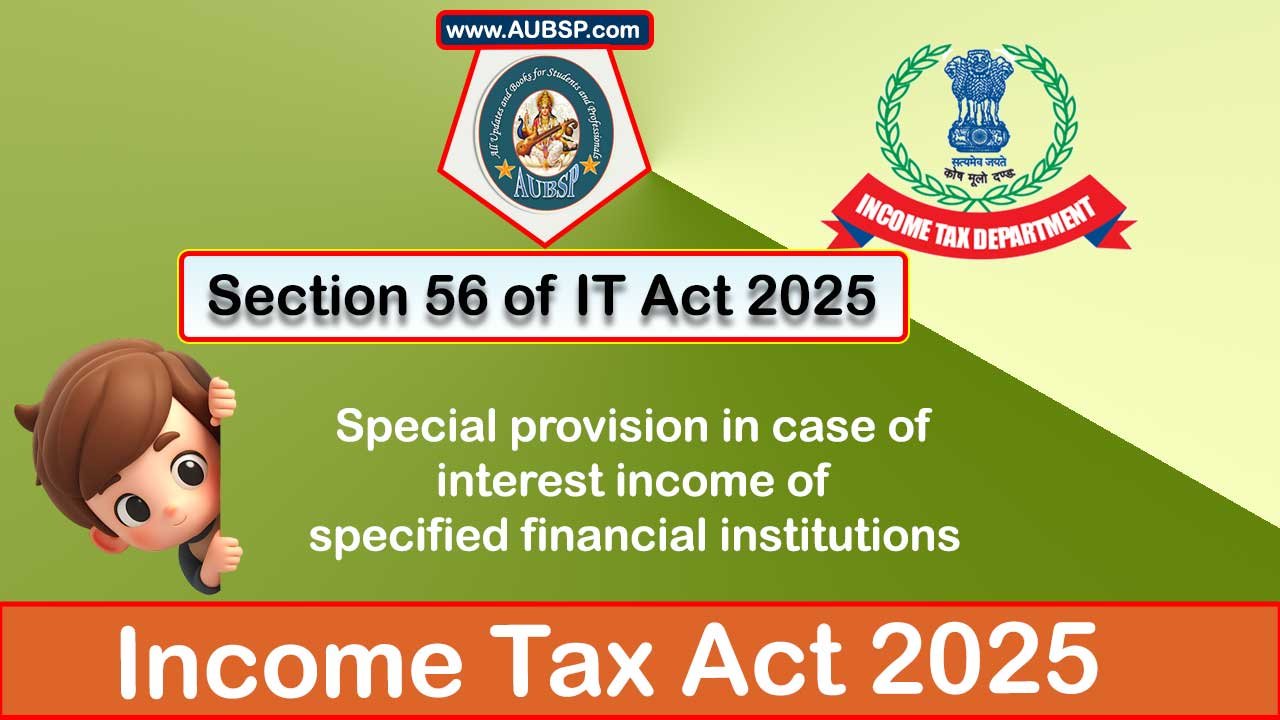Special provision in case of interest income of specified financial institutions
[As per the Income Tax Act, 2025 (this Act) w.e.f. 1st April, 2026.]
Section 56(1) of Income Tax Act 2025
56(1) Irrespective of anything to the contrary contained in this Act, the interest income in relation to bad or doubtful debts of a specified financial institution shall be chargeable to tax under the head “Profits and gains of business or profession” in the tax year in which such interest is—
- (a) credited to the profit and loss account; or
- (b) actually received,
whichever is earlier.
Section 56(2) of Income Tax Act 2025
56(2) In this section,––
- 56(2)(a) “specified financial institution” means––
- (i) a public financial institution; or
- (ii) a scheduled bank; or
- (iii) a co-operative bank, other than––
- (A) a primary agricultural credit society; or
- (B) a primary co-operative agricultural and rural development bank; or
- (iv) a State Financial Corporation; or
- (v) a State Industrial Investment Corporation; or
- (vi) any such class of non-banking financial companies, as notified by the Central Government;
- 56(2)(b) “bad or doubtful debts” shall be such categories of debts, as prescribed, having regard to the guidelines issued in relation to such debts by the Reserve Bank of India.
FAQs on Section 56 of Income Tax Act 2025
Q1. What is the primary objective of Section 56(1) of the Income Tax Act, 2025?
The primary objective is to prescribe a special rule for taxing interest income related to bad or doubtful debts of specified financial institutions under the head “Profits and gains of business or profession.”
Q2. When is interest income on bad or doubtful debts taxed under Section 56(1)?
The interest income is taxed in the tax year in which it is either credited to the profit and loss account or actually received, whichever is earlier.
Q3. Does Section 56(1) override other provisions of the Act?
Yes, Section 56(1) applies irrespective of anything contrary contained in the Income Tax Act.
Q4. What types of entities are considered “specified financial institutions” under Section 56(2)(a)?
“Specified financial institutions” include:
- Public financial institutions
- Scheduled banks
- Co-operative banks (excluding primary agricultural credit societies and primary co-operative agricultural and rural development banks)
- State Financial Corporations
- State Industrial Investment Corporations
- Notified classes of non-banking financial companies
Q5. Are primary agricultural credit societies covered under “co-operative banks” in this provision?
No, primary agricultural credit societies are specifically excluded from the definition of “co-operative banks” under this section.
Q6. What are “bad or doubtful debts” for the purpose of Section 56?
These refer to categories of debts prescribed by the rules, keeping in view the Reserve Bank of India’s guidelines.
Q7. Who is responsible for prescribing the categories of bad or doubtful debts?
The Central Government is empowered to prescribe these categories by considering RBI’s issued guidelines.
Q8. How is the taxation point determined under Section 56(1)?
Tax is levied at the earlier of the two events—when the interest is credited to the profit and loss account or when it is actually received.
Q9. Is this special provision applicable to non-financial entities?
No, it specifically applies only to specified financial institutions as defined under Section 56(2)(a).
Q10. Is interest income from all loans or advances covered under this section?
No, only interest income relating to bad or doubtful debts is covered.
Q11. If a scheduled bank receives interest in cash but has not credited it in its books, will it be taxable?
Yes, as per Section 56(1), the interest income will be taxable in the year of actual receipt even if not credited.
Q12. Can an institution defer taxation of interest on bad debts until recovery?
No, taxation cannot be deferred beyond the earlier of crediting the income to P&L or actual receipt.
Q13. Are NBFCs automatically included as specified financial institutions?
Only those classes of NBFCs that are notified by the Central Government are included.
Q14. Is Section 56 applicable to foreign banks operating in India?
Only if they qualify as scheduled banks or are notified by the Central Government under the specified class.
Q15. Does this section apply to interest income on standard assets?
No, it applies only to interest income relating to bad or doubtful debts.
Q16. Will tax audit reports need to disclose such interest income separately?
Yes, for compliance and proper reporting, such income should be disclosed under relevant clauses.
Q17. If an institution writes off the interest income without crediting to P&L or receiving it, is it taxable?
No, in such a case, it would not be taxable under Section 56(1) unless one of the two conditions—credit or receipt—is met.
Q18. Is this provision applicable from the financial year 2025–26 onwards?
Yes, it is applicable w.e.f. 1st April, 2026, meaning it applies from the assessment year 2026–27 onwards.
Q19. Does the section apply differently based on the accounting method followed?
No, it overrides other provisions and applies irrespective of the accounting method.
Q20. What is the rationale behind this special provision?
The rationale is to ensure timely taxation of interest income on impaired assets, thereby curbing indefinite deferral of tax liability.
Section 56 of the Income Tax Act, 2025 provides a special mechanism for taxing interest income related to bad or doubtful debts of specified financial institutions. By mandating taxability in the tax year in which such interest is either credited to the profit and loss account or actually received, whichever is earlier, the provision ensures that income recognition for tax purposes aligns with practical and regulatory realities. This approach minimizes tax deferral and enhances compliance consistency, particularly for financial entities governed by RBI norms.

